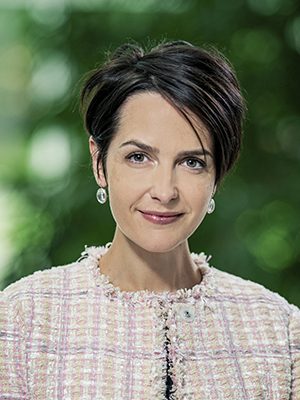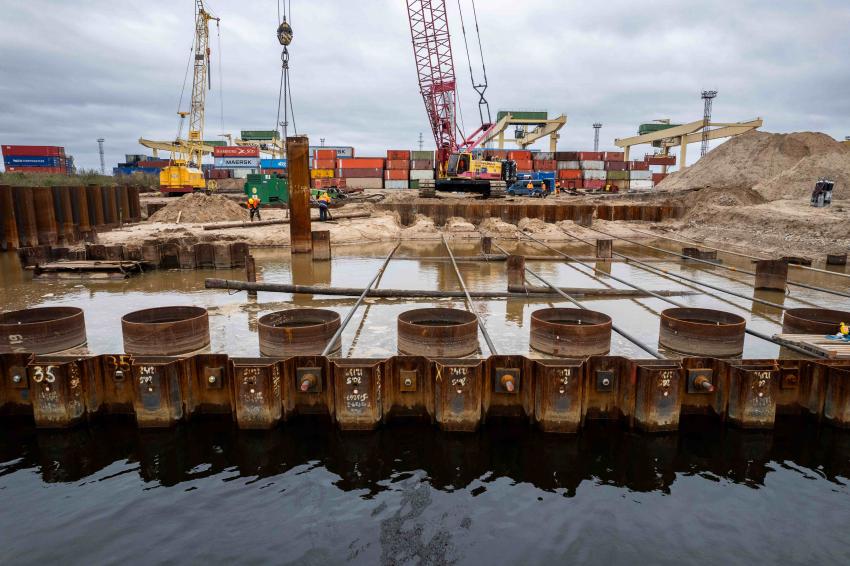Construction works are underway in Kundziņsala at the Baltic Container Terminal (BCT), the largest container terminal of the Port of Riga. The underwater works aimed at the construction of a new berth section have been completed. At the end of the project, the process of loading and unloading cargo at the terminal will be accelerated, increasing the terminal's operational efficiency and commercial competitiveness. Considering that the terminal accommodates military vessels, the berth capacity growth will be an investment into increasing military mobility and strengthening the common security of our country and NATO.
The project provides for the extension of the BCT berth KS - 34 by 57.3 meters, with the construction of its additional section. As a result, the overall length of the BCT berth line, combining three berths, will reach a total of 506.3 meters. Due to increased terminal capacity it will be possible to simultaneously moor and service two large vessels - container ships, ro-ro vessels (cargo ferries) or military ships, as well as moor vessels up to 340 meters in length.
“The construction of port berths is a unique and complex process that requires great responsibility, specific knowledge, experience and extensive resources. A new berth is an important event for the port, an important contribution to the development of its infrastructure and increasing the port’s competitiveness, improving our military mobility and that of allies of Latvia,” emphasized Ansis Zeltiņš, the Freeport of Riga CEO.
“The biggest challenge in the design of the berth is to provide the necessary load resistance. Ships weighing up to 79,000 tons with cargo will be moored at the new BCT berth, and it is planned to mount a 999-ton port crane on the berth. There will be a constant movement of trucks, port equipment and military transport, as well as the movement of containers, which can reach a maximum weight of up to 30 tons,” commented Andris Razgalis, the author of the project from the engineering company “Kurbada tilti”.
“Container ships, when compared to other types of vessels, have a much larger surface area above the water exposed to the wind. That is why the largest bollards (ship's mooring posts) with a load-bearing capacity of 150 tons are to be built at the new berth of the port of Riga . A solution to install larger fenders between the ship and the berth without reducing the ability of the cranes with the aim of reaching the farthest loads will be implemented. The fenders will be partially embedded into the berth’s superstructure,” said the project author addressing the project's challenges.
For the construction of the new berth section of the BCT, 280 sheet piles with a length of 20.5m have been used. They were driven into the riverbed 19.5 m below the water level by special technology, forming a continuous sheet pile wall. In addition, 24 pipe piles have been driven into the riverbed – these 21m long pipes with a diameter of 1.42 m will support the rail-mounted gantry crane located at the berth. The outer sheet pile wall is additionally attached to the shore with about 31m long horizontal anchor rods. The total length of the anchor rods reaches 934 meters. During the riverbed cleaning the inappropriate soil - silt and fine sand in the amount of 7800m³ was dredged from the berth area.
“One can say that we have completed the most challenging and difficult part of the berth construction process - we have built the basic structure of the berth. Most of the work that has been completed is underwater and will not be visible once the berth superstructure is finished. At this current stage, the most challenging aspect is performing work on the water, which requires continuous adaptation to changing and unpredictable conditions such as wind, waves, water level. Furthermore, when commencing work, predicting the riverbed's content is impossible. For instance, during sheet pile driving, we encountered an unexpected obstacle submerged in the riverbed. Unlike land-based projects, we could not simply excavate and inspect it. Instead, we had to engage divers and specialized equipment to extract the obstacle”, said Dmitrijs Bulkins, construction manager of the JSC “BMGS”.
The new berth section of the BCT is being built within the framework of a tripartite agreement concluded between the Freeport of Riga Authority, the European Climate, Infrastructure and Environment Agency (CINEA) and SIA Baltic Container Terminal (BCT). The agreement on increasing the dual use capacity of the Port of Riga by improving the port infrastructure in Kundziņsala was concluded in the spring of this year and provides for strengthening the commercial competitiveness of the Port of Riga, as well as improving the military mobility of Latvia and its allies.
Currently, construction works related to other port infrastructure projects, which are provided for within the framework of this agreement, are underway in Kundziņsala The reconstruction of the car and railway bridge in the southern part of Kundziņsala has been completed, while the Freeport of Riga Authority is currently carrying out reconstruction of the railway level crossing on Uriekstes Street near the port control post, reconstruction of the motorway in Kundziņsala from the bridge to the container terminal BCT, as well as construction of a new connecting road from the container terminal to the transport parking lot. All activities within the framework of the project are planned to be completed in full by the end of 2024.
Information for media

- [email protected], +371 670 308 53
- Freeport of Riga Authority
- 12 Kalpaka blvd, Riga, Latvia, LV-1010
 English
English























